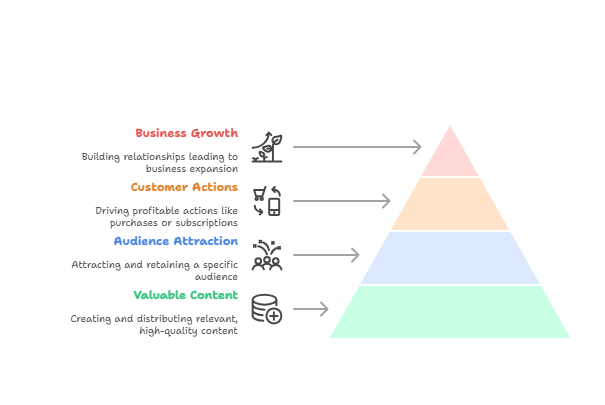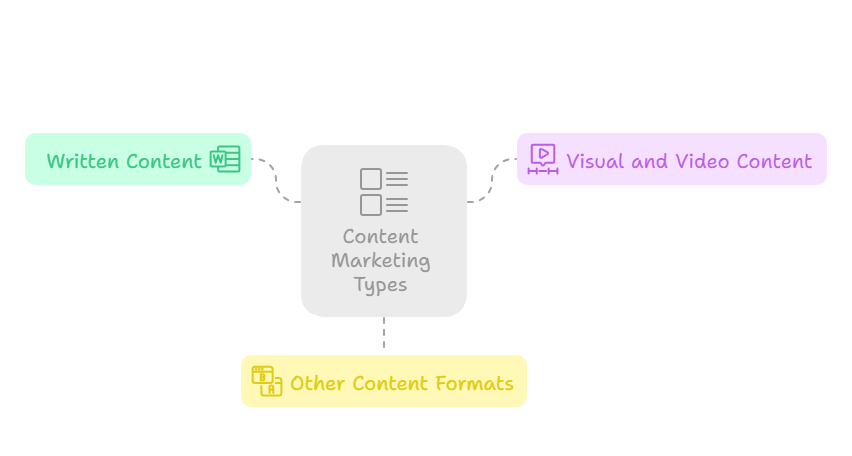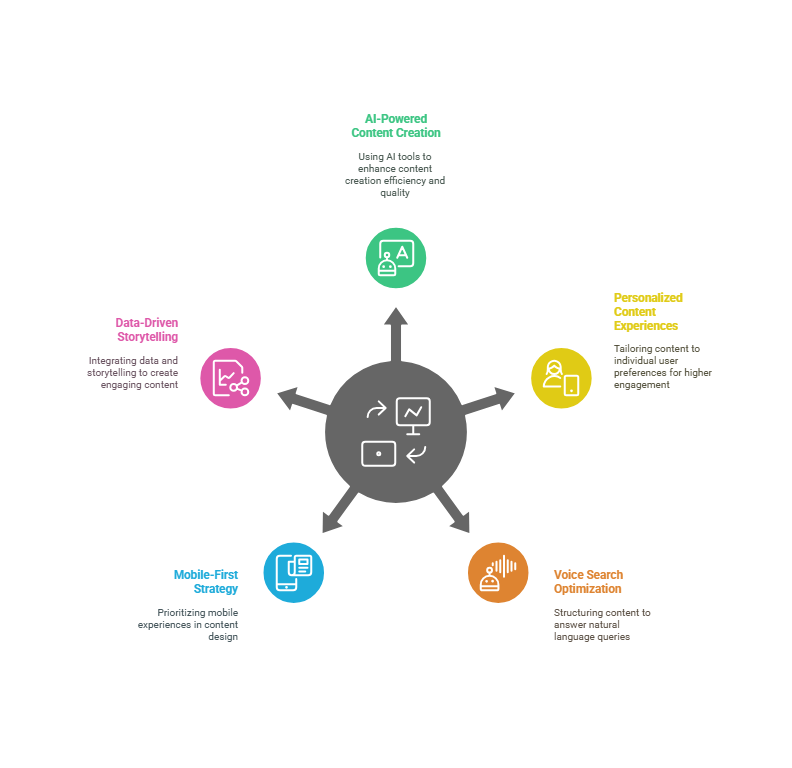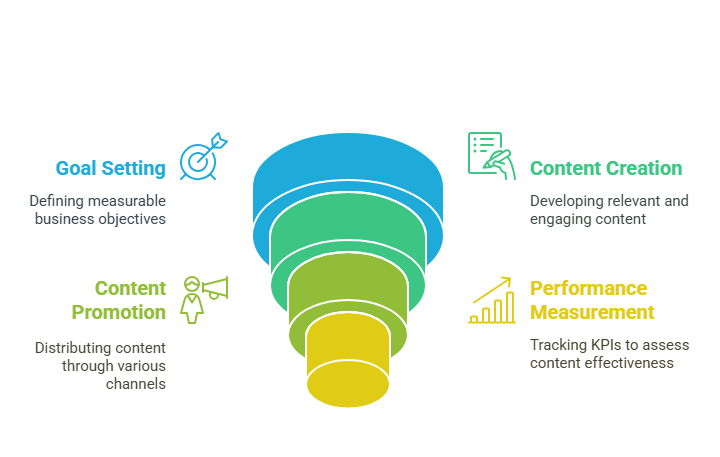Content marketing isn’t just another buzzword—it’s the backbone of modern digital strategy. In 2025, businesses leveraging strategic content marketing are experiencing 3x higher lead generation rates compared to traditional advertising methods, according to the latest Content Marketing Institute research.
If you’re still throwing random blog posts online hoping something sticks, you’re missing massive opportunities. Today’s content marketing requires precision, strategy, and deep understanding of audience psychology.
This comprehensive guide reveals battle-tested strategies, cutting-edge tools, and insider secrets that top marketers use to dominate their industries through content.
Ready to transform your approach?
What is Content Marketing?
Content marketing represents a strategic approach focused on creating and distributing valuable, relevant content to attract and retain clearly defined audiences—ultimately driving profitable customer actions.
Content marketing means creating and sharing valuable content to attract and keep a specific audience, eventually driving them to take action like making purchases, subscribing, or engaging with your brand.
Think about it differently: instead of interrupting people with unwanted advertisements, you’re providing solutions they actively seek. You become the trusted advisor who consistently delivers value, building relationships that naturally lead to business growth.

“Content marketing is about understanding that if you as a business took the role of publisher and created content on a regular basis, then you would have an audience that would be naturally attracted to doing business with you.” – Joe Pulizzi, Content Marketing Institute.
Why It Matters
Content marketing’s power lies in its compound effect on business growth:
- Builds trust with your audience: Consistent value delivery establishes you as an industry authority. 88% of consumers trust brands that consistently provide helpful content according to HubSpot’s 2024 Marketing Report.
- Improves brand awareness: Quality content increases visibility across search engines and social platforms, expanding your reach organically.
- Boosts SEO rankings: Search engines prioritize websites publishing fresh, valuable content. Companies with blogs generate 67% more leads monthly than those without, reports Ahrefs.
- Drives long-term traffic and leads: Unlike paid advertising, quality content continues attracting visitors months or years after publication, creating sustainable growth.
The most compelling aspect? Content marketing costs 62% less than traditional marketing while generating three times more leads, according to Demand Metric research.
Core Content Marketing Types
Different content formats serve distinct purposes throughout the customer journey. Understanding when and how to deploy each type maximizes your marketing effectiveness.

Written Content
Written content remains the foundation of successful content strategies, offering versatility and strong SEO benefits:
- Blogs: Your primary content vehicle for establishing thought leadership and capturing search traffic. Effective blog content answers specific questions your audience asks while strategically incorporating target keywords.
- Case Studies: Powerful social proof that demonstrates real results with actual customers. These detailed success stories remove purchase objections and provide concrete evidence of your solution’s effectiveness.
- Whitepapers: In-depth research documents that showcase expertise while capturing qualified leads. They work exceptionally well for B2B audiences seeking comprehensive information before making decisions.
- Email Newsletters: Direct communication channel that nurtures relationships and drives repeat engagement. Newsletters keep your brand visible while providing ongoing value to subscribers.
Visual and Video Content
Visual content generates significantly higher engagement rates. Visual content receives 94% more views than text-only content, according to HubSpot research:
- Infographics: Perfect for simplifying complex information into shareable, digestible formats. They attract backlinks naturally and perform well across social media platforms.
- YouTube Videos: Essential for reaching audiences on the world’s second-largest search engine. Long-form videos excel at tutorials, demonstrations, and thought leadership content.
- Webinars: Live educational sessions that provide immense value while positioning you as an expert. They generate high-quality leads and enable direct audience interaction.
- Short-form Videos (TikTok, Reels, Shorts): Critical for brand awareness and reaching younger demographics. These bite-sized videos capture attention quickly and encourage sharing.
Other Content Formats
Diversifying beyond traditional formats can differentiate your brand:
- Podcasts: Audio content experiences explosive growth. 62% of consumers have listened to podcasts monthly in 2025, reports Statista. Podcasts build intimate audience relationships and work perfectly for busy professionals.
- eBooks: Comprehensive guides that provide substantial value while capturing leads. They establish authority and offer significant perceived value in exchange for contact information.
- Interactive content (Quizzes, Polls): Engages audiences actively rather than passively. Interactive content generates 2x more conversions than passive content, according to Content Marketing Institute data.
Content Marketing Trends for 2025
The content marketing landscape evolves rapidly. Staying ahead of these trends ensures competitive advantage and maximum ROI from your efforts.

1. AI-Powered Content Creation
Use tools like ChatGPT, Jasper, and SurferSEO to write, optimize, and scale content faster while maintaining quality and relevance.
“AI won’t replace content creators, but content creators using AI will replace those who don’t. The key is maintaining human creativity while leveraging AI efficiency.” – Neil Patel, NeilPatel.com
Smart marketers use AI for ideation, first drafts, and optimization while preserving human insight for strategy and unique perspectives. 73% of marketers report AI tools increased their content production speed by 50% or more, according to Semrush’s AI Marketing Report 2024.
2. Personalized Content Experiences
Leverage CRM data and automation to deliver content that feels tailor-made for each visitor, increasing engagement and conversion rates.
Generic content is losing effectiveness rapidly. Today’s consumers expect personalized experiences, and technology finally enables delivery at scale. This involves showing different content based on industry, company size, previous interactions, or buyer journey stage.
Personalized content experiences increase conversion rates by 20% on average, reports HubSpot’s Personalization Research.
3. Voice Search Optimization
Structure content to answer natural language queries for smart speakers and mobile users who increasingly search conversationally.
Voice search fundamentally changes how people find information. Instead of typing “best pizza NYC,” users say “Hey Google, what’s the best pizza place near me?” Your content must answer these conversational queries directly.
55% of households will own smart speakers by 2025, according to Statista projections.
4. Mobile-First & Omnichannel Strategy
Create content that looks exceptional and loads fast on all devices, from Instagram to email, prioritizing mobile experiences.
Mobile traffic accounts for 63% of all web traffic in 2025, reports SimilarWeb. Yet many businesses still design desktop-first, missing massive opportunities.
5. Data-Driven Storytelling
Incorporate real statistics, visuals, and user behavior data to make your content more engaging and credible while building trust.
“Data tells you what happened. Storytelling tells you why it matters. Combining both creates content that resonates and converts.” – Ann Handley, MarketingProfs
How to Build a Content Marketing Strategy
Successful content marketing requires systematic planning rather than random content creation. Follow this proven framework for measurable results.

Step 1: Know Your Audience
Create detailed buyer personas and use real data to understand their needs, challenges, and content preferences.
Avoid the “everyone” trap—your audience consists of specific groups with specific problems your business solves. Analyze existing customers, review support tickets, and conduct surveys to understand their goals, frustrations, and preferred content formats.
Develop detailed personas including demographics, psychographics, content consumption habits, and decision-making processes. The more specific your understanding, the more effective your content becomes.
Step 2: Set Clear Goals
Your content marketing must serve specific business objectives with measurable outcomes:
- Boost organic traffic: Target keywords your audience actively searches for, creating content that ranks well and drives qualified visitors.
- Increase leads or sales: Design content with clear calls-to-action and lead magnets that move prospects through your funnel.
- Improve engagement or retention: Help existing customers extract more value from your products or services, reducing churn and increasing lifetime value.
Each content piece should serve specific goals rather than generic “brand awareness.” Measurable objectives enable optimization and demonstrate ROI.
Step 3: Choose the Right Content Types
Match formats to your customer journey—from blogs at the top to case studies near purchase decisions.
Different content works better at different funnel stages. Awareness-stage prospects need educational content explaining their problems. Consideration-stage prospects want solution comparisons and detailed guides. Decision-stage prospects require case studies, testimonials, and product demonstrations.
Step 4: Create a Content Calendar
Use tools like Trello or Notion to plan your topics, channels, and publishing dates in advance, ensuring consistency.
Consistency builds audience trust and search engine favor. Plan content around important dates, product launches, industry events, and seasonal trends. Include topic, target keywords, format, distribution channels, and publishing dates for each piece.
Step 5: Promote Your Content
Creating excellent content is only half the battle—strategic promotion ensures maximum reach and impact:
- SEO optimization: Optimize content for search engines so your audience finds it when seeking solutions.
- Email marketing: Share your best content with subscribers who’ve already expressed interest in your brand.
- Social media sharing: Adapt content for different platforms, recognizing that LinkedIn content differs from TikTok content.
- Repurposing into multiple formats: Transform one piece into many—blog posts become videos, infographics, podcast episodes, and social media series.
Measuring Success: KPIs & ROI
Content marketing without measurement is expensive creative writing. Track the right metrics to optimize performance and demonstrate business impact.
Key Performance Indicators (KPIs)
Focus on metrics that directly correlate with business outcomes:
- Website traffic: Monitor both overall traffic and traffic to specific content pieces, identifying top performers.
- Time on page: Longer engagement indicates more valuable content that truly resonates with your audience.
- Lead conversions: Track how many visitors take desired actions after consuming content—downloads, signups, or demo requests.
- Click-through rate (CTR): Measure how effectively your calls-to-action motivate desired behaviors.
- Customer retention: Determine whether content consumption correlates with reduced churn and increased customer lifetime value.
How to Prove ROI
Track performance using tools like Google Analytics, CRM reports, and UTM codes to link content efforts to revenue generation.
Use UTM codes for tracking which content drives traffic and conversions. Set up conversion tracking in Google Analytics to identify content contributing to sales. Collaborate with sales teams to understand which content helps close deals.
Companies using data-driven content strategies see 6x higher conversion rates, according to Content Marketing Institute research.
Top Tools for Content Marketing
The right tools streamline content creation, optimization, and distribution while scaling your efforts efficiently.
Content Creation
- Jasper: AI-powered writing assistant that accelerates first draft creation and overcomes writer’s block, particularly effective for generating headline variations and social media posts.
- Grammarly: Advanced writing enhancement tool that ensures clarity, engagement, and error-free content with tone and clarity suggestions.
- Canva: Design platform that creates professional graphics without design experience, perfect for social media posts, infographics, and blog headers.
SEO & Optimization
- SurferSEO: Content optimization tool that analyzes top-ranking pages and provides specific recommendations for improving search performance.
- Clearscope: Helps optimize content for search by analyzing successful content topics and keywords for target terms.
- Ahrefs: Comprehensive SEO platform invaluable for keyword research, competitor analysis, and tracking content search performance over time.
Distribution & Automation
- Buffer / Hootsuite: Social media management platforms for scheduling posts across multiple platforms and tracking engagement metrics.
- Mailchimp: Email marketing platform for creating newsletters, automating email sequences, and tracking email performance.
- HubSpot: All-in-one marketing platform including content management, email marketing, social media tools, and detailed analytics.
Final Tips for 2025 Success
These fundamental principles determine content marketing success in 2025 and beyond:
- Update content regularly to match algorithm and trend changes: The digital landscape moves rapidly. Stay current with platform updates, algorithm changes, and shifting audience preferences.
- Blend automation with human creativity: Use AI and automation for repetitive tasks while preserving the human touch that makes content unique and relatable.
- Focus on value, not just volume: One truly valuable piece outweighs ten mediocre pieces. Quality consistently wins long-term.
- Monitor what’s working—and double down: Pay attention to analytics and pivot when something isn’t working. When you discover resonant content, create more of it.
“Content marketing success comes from understanding that your audience’s success is your success. Help them win, and you’ll win too.” – Marcus Sheridan, The Sales Lion
FAQs About Content Marketing
Address common questions that arise when businesses begin their content marketing journey.
How often should I publish content?
Start with 1–2 pieces per week, then scale as you see results and develop efficient processes.
Consistency matters more than frequency when starting. Better to publish one high-quality piece weekly for a year than daily for a month before burning out. Gradually increase frequency as you develop systems and see audience response.
Which platforms are best for B2B content?
LinkedIn, blogs, newsletters, and industry webinars work exceptionally well for B2B audiences seeking professional, research-focused content.
B2B audiences consume content more professionally and research-focused. LinkedIn provides direct access to business decision-makers, while your blog should anchor your content strategy with other platforms driving traffic back to your website.
Is content marketing expensive?
It can be budget-friendly if you use the right tools and focus on organic growth rather than paid promotion.
Content marketing scales with your budget and commitment. Start with basic tools and consistent publishing, reinvesting results into scaling efforts. Content marketing delivers 3x more leads per dollar spent compared to paid advertising, according to Content Marketing Institute data.
Content marketing represents the foundation of modern business growth. Master these fundamentals, stay consistent, and always prioritize providing genuine value to your audience. Success follows naturally when you consistently help your audience achieve their goals.


